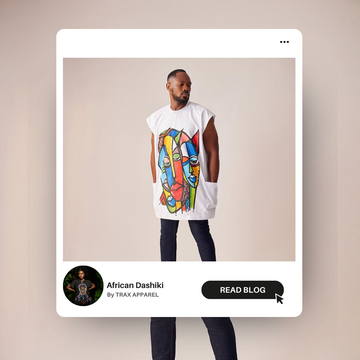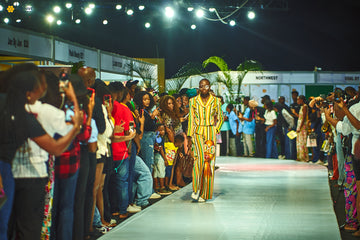Origin of Dashiki
The Dashiki is a loose-fitting garment with a rich history in West African fashion. Between Nigeria, Togo, Benin, and Senegal Dashiki’s root was established thousands of years ago and has become a cultural symbol of identity and pride for Africans at home and in the diaspora.
Traditionally worn by men, it's known for its V-neckline and vibrant patterns.
Made from breathable fabrics like cotton, the dashiki was designed for comfort in Africa's hot climate.
Popular Dashiki Styles
In some regions, the dashiki can be dressed up for formal occasions. Here are a few examples:

- Dashiki Suit: This combination features the classic dashiki paired with Sokoto (drawstring pants) and a Kufi (embroidered cap). Often worn by grooms for weddings, it is common among the Hausas from Nigeria.
- Senegalese Kaftan: This ensemble consists of an ankle-length dashiki, a matching Kufi, and Sokoto pants.
- Grand Boubou: This regal attire features a dashiki worn with matching trousers and a flowing gown draped over it. Traditionally worn by tribal leaders, Nigerians, or Muslims in specific contexts.
- Agbada: This deserves an honorable mention! It could be argued that the Agbada is a style that evolved from the simple Dashiki to a more elaborate and royal attire common among the Yoruba in Nigeria.
The Dashiki Influence on Other Styles
The dashiki has transcended its origins as a practical garment to become a powerful symbol of African culture and style. Today, it's not uncommon to see it on women as statement dresses or flowing ankle-length gowns known as Abayas or Jalabiyas.
Jalabiya is a more unisex name as men also wear it, while women like to call their version ‘Abaya’.
Think of the Jalabiya as the dashiki's elegant, full-length cousin – the same iconic design, just a touch more formal.


Dashiki's Features
Both garments embrace a relaxed fit and are a favorite among men and women alike. The classic dashiki features a V-neck or round-neck design, offering a comfortable and versatile silhouette.
And of course, there are those essential pockets, adding practicality without compromising on style. Often, you'll also find embroidery gracing the neckline, adding a touch of cultural flair.

The Jalabiya shares these features, with its extended length being the key difference. This adaptation allows for a more formal look while retaining the Dashiki's core elements.
How Dashiki Has Influenced Fashion Globally
The influence of African fashion on the global stage is undeniable. While there can be debates about cultural appropriation, here at Trax Apparel, we celebrate the positive aspects of this exchange. The dashiki's journey from a traditional garment to a modern trendsetter is a testament to the enduring power of African design.

Fashion creatives across the globe have embraced the dashiki's potential, making it a truly adaptable piece. Some focus on using stunning African fabrics, while others experiment with the design itself. Yet, through these modifications, the core style and essence of this cultural treasure remain.

This adaptability highlights the importance of owning your narrative. African designers, like Trax Apparel, understand the power of telling our own stories through fashion and art. We ensure the dashiki's legacy continues to evolve while staying true to its rich heritage.
Thanks for joining us on this quick tour of the dashiki's fashion journey!
Trax Apparel offers unique pieces, explore our collection and embrace the dashiki's legacy in style!


